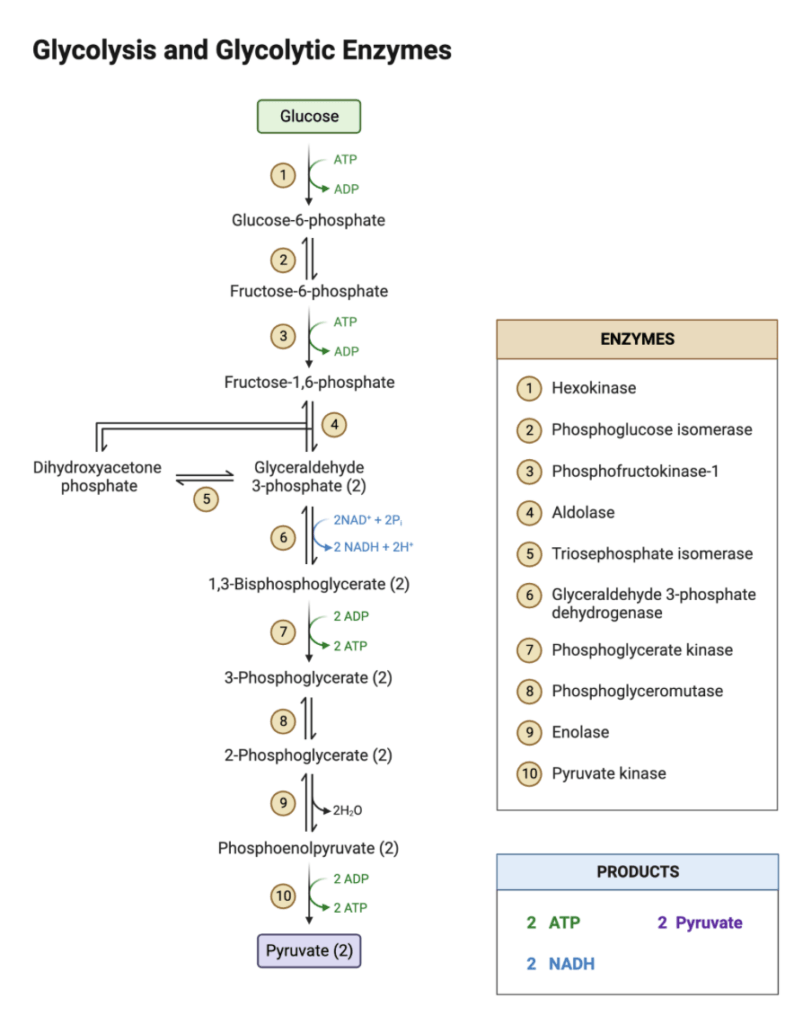Glycolysis is a crucial metabolic process that is essential for the generation of energy for cells. Through this pathway, glucose (6C) is broken down to 2 molecules of pyruvic acid (3C), which can then be further processed to produce ATP downstream. Glycolysis consists of 10 closely controlled enzymatic processes, it is found in the cytoplasm of the cell, outside mitochondria. Glycolysis can take place in a range of cell types and is an anaerobic process, which means it does not require oxygen.
Steps of Glycolysis

Phosphorylation of Glucose to produce glucose-6-phosphate by the enzyme Hexokinase. It requires one ATP molecule and Mg++.
Glucose-6-phosphate is isomerized to produce fructose-6-phosphate by the help of enzyme phosphohexose isomerase.
Phosphorylation of Fructose-6-phosphate to fructose-1,6-bisphosphate by the help of enzyme phosphofructokinase-1. It also requires one ATP molecule and Mg++
Fructose-1,6-bisphosphate (6C) is cleaved into two three-carbon molecules: glyceraldehyde-3-phosphateor 3-Phosphoglyceraldehyde(3-PGAI) (3C) and dihydroxyacetone 3- phosphate (3-DHAP) (3C) by the enzyme aldolase.3-PGAI and 3-DHAP are isomers.
Dihydroxyacetone 3-phosphate (3-DHAP) is isomerized into glyceraldehyde-3-phosphate by the enzyme triose phosphate isomerase.
Oxidation of Glyceraldehyde-3-phosphate by the enzyme glyceraldehyde-3-phosphate dehydrogenase, produces two molecules of NADH and one molecule of 1,3-bisphosphoglycerate. In this step, 1 hydrogen molecule from glyceraldehyde 3- phosphate is transferred to nicotinamide adenine dinucleotide to form NADH + H+.
1,3-bisphosphoglycerate donates one phosphate to ADP to make ATP, and itself is converted into 3-phosphoglycerate by the enzyme phosphoglycerate kinase. In this step two molecule of ATP is generated.
3-phosphoglycerate is converted into 2-phosphoglycerate by the enzyme phosphoglycerate mutase. Intramolecular transfer of phosphate group occurs.
2-phosphoglycerate is converted into phosphoenolpyruvate in the presence of enzyme enolase and Mg++, which eliminates a water molecule.
Phosphoenolpyruvate is converted into pyruvic acid by transfer of phosphate group from ATP to ADP by the enzyme pyruvate kinase. The end products are formed as two more molecules of ATP, and two molecules of pyruvic acid.
Description of Glycolysis
- The biochemical process that turns glucose into pyruvic acid is known as glycolysis.
- It is an anaerobic procedure that takes place in the cytoplasm of the cell and does not require oxygen.
- There are 10 enzymatic processes in the pathway, each of which is mediated by a distinct enzyme.
- . The “energy investment phase” of glycolysis, which consists of the first five processes, requires the input of two ATP molecules.
- The “energy payoff phase”, also known as the second set of five steps in glycolysis, results in a net surplus of two ATP molecules by producing four ATP molecules.
- Glycolysis pathway produces two molecules of NADH in addition to ATP, and this NADH can be used in oxidative phosphorylation to make more ATP.
- Both prokaryotic and eukaryotic cells depend on glycolysis as a major source of energy.
- Pyruvate, the byproduct of glycolysis, may undergo:
- Pyruvate produced from glucose will reach the mitochondria under aerobic conditions to go through oxidative phosphorylation.
- Pyruvate remains in the cytoplasm under anaerobic conditions, where it is transformed to lactate by the enzyme lactate dehydrogenase.
Energy Balance Sheet for glycolysis
| + | — | NET | Notes |
| 4 ATP/mole glucose 0 net NADH | 2 ATP/mole glucose | 2 ATP/mole glucose | In anaerobic glycolysis |
| 5 more ATPs | 5 ATPs | If oxygen is present, the 2 NADHs can donate a pair of electrons to the electron transport pathway in mitochondria and generate up to, making 7 ATPs total. | |
| TOTAL | 7 ATPs | ||
In addition to producing energy, glycolysis is essential for a number of other biological functions. For instance, glycolysis’s intermediates can be used to create crucial proteins like sugars and amino acids. Furthermore, disruption of glycolysis has been linked to numerous illnesses, such as cancer, diabetes, and neurodegenerative conditions. Therefore, it is crucial to comprehend how glycolysis works and how it is regulated in order to create novel therapeutic strategies to treat these illnesses. Overall, research into the regulation and function of the glycolysis pathway will surely continue to produce significant insights into the workings of cells and the mechanisms underlying human health and illness. The glycolysis pathway is a crucial process that is essential to cellular metabolism.